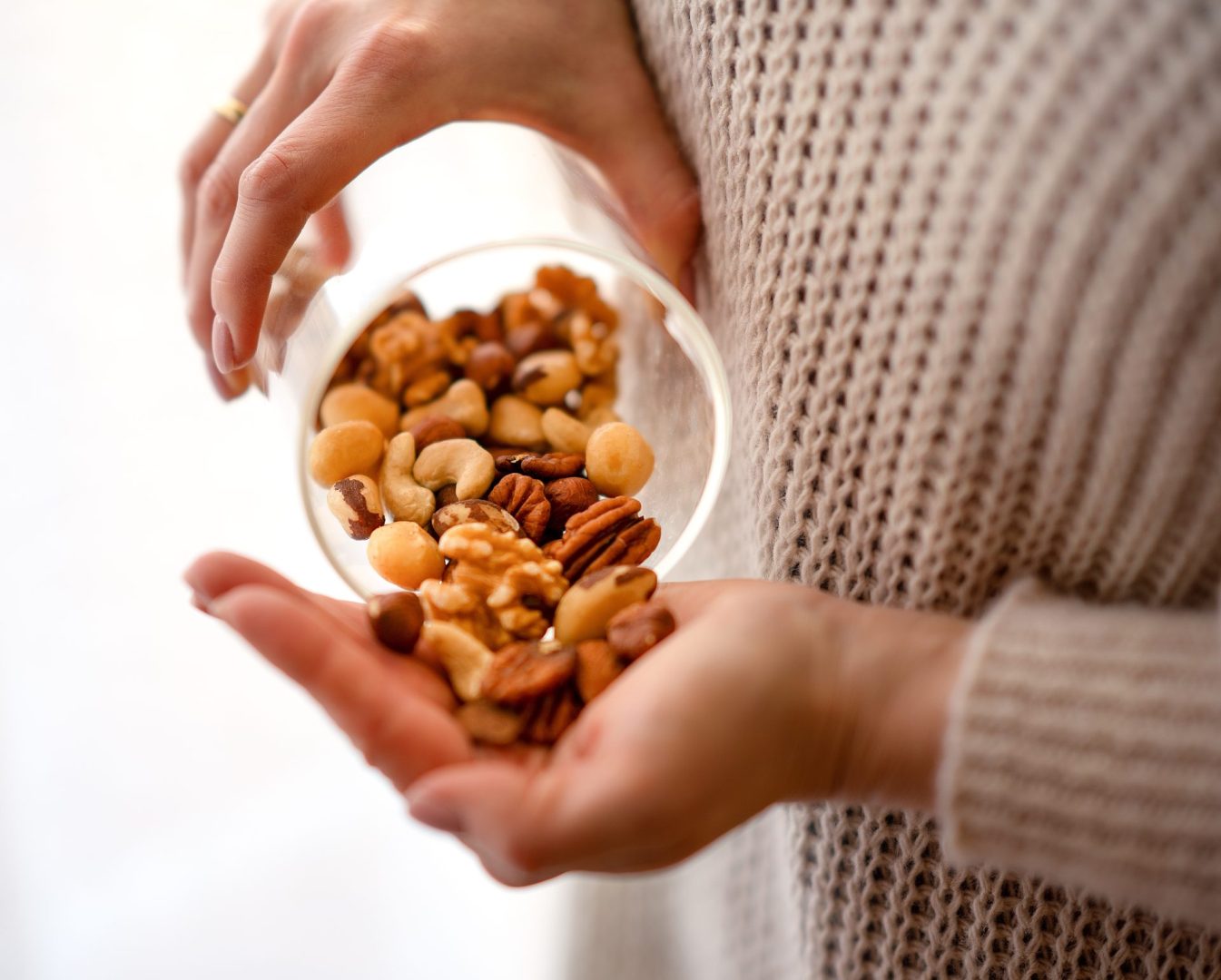Discover how these protein-packed powerhouses deliver lasting satiety with minimal effort
Why tiny nuts pack a powerful hunger-fighting punch
The quest for effective, natural hunger management continues to challenge many people trying to maintain healthy eating patterns. Morning hunger pangs often lead to unplanned snacking, diet disruption, and energy crashes that affect productivity. While numerous breakfast options promise lasting fullness, emerging research points to a surprisingly simple solution: consuming just five specific nuts might effectively curb hunger throughout the morning hours.
Nuts represent one of nature’s most nutrient-dense food packages, containing unique combinations of protein, fiber, healthy fats, and micronutrients that work synergistically to promote satiety. Their complex nutritional profile triggers multiple physiological mechanisms that regulate appetite and energy balance. This multifaceted approach to hunger management explains why such a small serving can potentially deliver extended satisfaction.
The “five nut” approach focuses on strategic selection rather than volume. By choosing specific varieties with complementary nutritional profiles, this minimal quantity potentially delivers maximum hunger-fighting benefits. This targeted approach aligns with research showing that quality often matters more than quantity when managing appetite hormones and blood sugar stability.
The 5 most effective hunger-controlling nuts
- Almonds lead the satiety rankings
Almonds consistently demonstrate superior hunger-controlling properties among common nut varieties. Their exceptional combination of protein (6 grams per ounce) and fiber (3.5 grams per ounce) creates a powerful satiety effect by slowing digestion and stabilizing blood glucose. The specific fiber type in almonds, particularly their skin, appears to function as a prebiotic that enhances gut hormone production linked to fullness.
Beyond macronutrients, almonds contain significant magnesium (76mg per ounce), which plays a crucial role in blood sugar regulation. This mineral helps prevent the glucose fluctuations that often trigger hunger. Additionally, almonds require significant chewing, which increases saliva production and gastric enzymes that signal satiety to the brain before you’ve even finished eating them.
- Pistachios deliver psychological and physiological satisfaction
Pistachios offer unique hunger management benefits through both physiological and psychological mechanisms. Their protein content (6 grams per ounce) ranks among the highest of commercially available nuts, providing essential amino acids that trigger CCK and GLP-1 hormone production associated with fullness. The distinctive advantage of pistachios comes from their shell, creating a natural portion control mechanism.
Research demonstrates that the act of shelling pistachios slows consumption, allowing satiety hormones time to activate before overconsumption occurs. This mindful eating process, combined with the visual feedback of empty shells, creates both physical and psychological satisfaction. Additionally, pistachios have the highest fiber content of common nuts at nearly 3 grams per ounce, further extending their digestive timeline.
- Walnuts offer unique brain-gut connection benefits
Walnuts stand apart in the nut family for their exceptional omega-3 fatty acid content, particularly alpha-linolenic acid (ALA), which influences appetite regulation through multiple pathways. These fatty acids affect hypothalamic receptors that control hunger signals while simultaneously supporting serotonin production, which influences appetite perception. This brain-centered approach complements the physical fullness provided by other nuts.
The polyunsaturated fats in walnuts also stimulate the release of cholecystokinin, a hormone directly linked to appetite suppression. Additionally, walnuts contain melatonin and serotonin, which play roles in regulating the circadian rhythms that influence hunger patterns throughout the day. This combination makes walnuts particularly valuable for morning consumption when setting the day’s metabolic tone.
- Brazil nuts deliver selenium-powered satiety
Brazil nuts contain exceptional selenium concentrations—just one nut provides over 100% of the daily recommended intake. This mineral plays critical roles in thyroid function, which directly affects metabolism and hunger regulation. Proper thyroid hormone production helps maintain consistent energy levels throughout the morning, preventing the dips that often trigger hunger pangs.
Beyond selenium, Brazil nuts contain significant amounts of the amino acid arginine, which supports healthy blood flow and nutrient delivery throughout the body. This improved circulation ensures that satiety signals reach the brain efficiently. Additionally, their substantial phosphorus content (about 18% of daily needs in a single nut) supports cellular energy production, helping maintain consistent energy levels throughout the morning.
- Macadamia nuts provide unique monounsaturated fats
Macadamia nuts contain the highest proportion of monounsaturated fats among all nuts, primarily in the form of oleic acid—the same heart-healthy fat found in olive oil. This fat profile slows gastric emptying, extending the digestion process and prolonging satiety. These fats also support the production of adiponectin, a hormone that regulates glucose levels and fatty acid breakdown, helping maintain stable energy throughout the morning.
The unique texture of macadamia nuts requires significant chewing, which activates mechanical receptors in the jaw that signal fullness to the brain. Their buttery consistency also provides exceptional sensory satisfaction, addressing the psychological aspects of hunger with minimal quantity. Though lower in protein than some other nuts, their exceptional fat quality complements the protein-rich varieties in a strategic five-nut combination.
The science behind morning hunger management
Understanding why just five nuts could potentially curb morning hunger requires examining several interconnected physiological mechanisms that influence satiety:
Blood glucose stabilization represents perhaps the most immediate effect of nut consumption. The combination of protein, fiber, and healthy fats creates a “slow-release” energy profile that prevents the blood sugar spikes and crashes associated with refined carbohydrates. This steady glucose profile helps maintain consistent energy levels throughout the morning, preventing the hypoglycemic dips that trigger hunger pangs.
Hormone regulation follows as nuts influence multiple appetite-controlling hormones. Protein components stimulate cholecystokinin (CCK) and glucagon-like peptide-1 (GLP-1), which signal fullness to the brain. Simultaneously, the fat content in nuts, particularly monounsaturated and omega-3 fatty acids, helps suppress ghrelin—often called the “hunger hormone.” This multilayered hormonal influence creates a comprehensive approach to appetite management.
Digestive timeline extension occurs as the fiber, protein, and fat matrix in nuts significantly slows gastric emptying. This prolonged digestive process ensures nutrients enter the bloodstream gradually, extending the satiety window. The specific fiber types in nuts also feed beneficial gut bacteria, which produce short-chain fatty acids that further support appetite regulation through additional hormonal pathways.
Micronutrient influences represent an often overlooked aspect of satiety. The mineral profile of nuts—particularly magnesium, zinc, and selenium—supports numerous metabolic processes related to energy production and utilization. These micronutrients help optimize cellular energy efficiency, reducing the physiological drive to consume more calories when metabolic processes function optimally.
Creating the optimal 5-nut morning protocol
To maximize hunger-controlling benefits from a minimal nut serving, implementation details matter significantly:
The timing of consumption plays a crucial role in effectiveness. Consuming the five-nut combination approximately 30 minutes before typical hunger pangs occur allows the digestion process to begin releasing satiety hormones at the optimal moment. For most people, this means eating nuts immediately upon waking or about 30 minutes before leaving home in the morning.
Proper preparation enhances nutrient availability from nuts. Light toasting (at temperatures below 170°F/77°C) can increase the bioavailability of certain proteins and antioxidants without damaging heat-sensitive nutrients. Additionally, soaking nuts overnight may reduce phytic acid levels, potentially improving mineral absorption, though evidence remains mixed on whether this significantly affects satiety.
Strategic combinations maximize complementary benefits. Pairing one Brazil nut (for selenium), two almonds (for protein and fiber), one walnut (for omega-3s), two pistachios (for mindful eating benefits), and one macadamia nut (for monounsaturated fats) creates a synergistic effect greater than consuming five of any single variety. This diversity ensures multiple satiety pathways activate simultaneously.
Proper chewing technique dramatically affects how the body processes nuts. Thoroughly grinding each nut with 20-30 chewing cycles releases more nutrients and signals satisfaction to the brain through mechanical receptors in the jaw. This extended chewing process also allows time for the olfactory system to register the nuts’ aromas, activating additional satiety pathways through sensory stimulation.
When 5 nuts might not provide enough satiety
While the 5-nut approach offers significant hunger management potential, several factors influence individual response:
Metabolic rate variations significantly impact hunger patterns. Individuals with naturally higher metabolic rates, particularly those with more muscle mass or who regularly engage in high-intensity exercise, typically require more substantial caloric intake. For these individuals, five nuts may initiate satiety mechanisms but provide insufficient energy to maintain fullness throughout the entire morning.
Activity level differences create varying caloric needs. People with physically demanding morning routines or who exercise before noon may experience stronger hunger signals despite the satiety-promoting effects of nuts. In these cases, the five-nut approach might serve as a strategic pre-breakfast snack rather than a breakfast replacement.
Hormonal influences, particularly for women during certain phases of the menstrual cycle, can intensify hunger signals. During the luteal phase (days 15-28), many women experience increased caloric needs and stronger hunger sensations. During these periods, the five-nut approach might require supplementation with additional protein or fiber sources to maintain effectiveness.
Medication effects can override natural satiety signals. Certain medications, including some antidepressants, corticosteroids, and antihistamines, may increase appetite regardless of nutritional intake. People taking these medications might benefit from combining the five-nut approach with additional hunger management strategies for optimal results.
Sleep quality significantly impacts morning hunger hormones. Inadequate sleep increases ghrelin production while decreasing leptin, creating stronger hunger sensations regardless of what you eat. Those experiencing poor sleep might notice reduced effectiveness from the five-nut approach until addressing their sleep quality.
Enhancing the 5-nut strategy for maximum effectiveness
Several complementary approaches can amplify the hunger-controlling benefits of the minimal nut serving:
Hydration status significantly influences perceived hunger, as thirst signals often misinterpret as hunger. Consuming 12-16 ounces of water before the five-nut serving helps activate stretch receptors in the stomach, initiating preliminary fullness signals. Additionally, proper hydration optimizes the enzymatic processes involved in nutrient extraction from the nuts.
Mindful consumption techniques enhance satiety signaling. Taking time to appreciate the texture, flavor, and aroma of each nut activates multiple sensory pathways that contribute to satisfaction. This attention to sensory experience increases the psychological components of satiety, which can be equally important as physiological factors in managing perceived hunger.
Pairing with strategic companions can extend the nuts’ effectiveness. Adding a small apple provides additional fiber (particularly pectin) that complements the nuts’ satiety mechanisms while adding minimal calories. Alternatively, a cup of green tea contains catechins that may temporarily increase metabolism while providing a volume of liquid that activates stomach stretch receptors.
Time-restricted eating frameworks maximize the nuts’ effectiveness by aligning consumption with natural circadian rhythms. Consuming the five-nut serving at the beginning of an 8-10 hour eating window helps establish metabolic expectations for the day. This approach leverages the body’s natural tendency to process nutrients more efficiently during daylight hours.
The economic and practical advantages of the 5-nut approach
Beyond nutritional benefits, this minimal approach offers several practical advantages:
Cost-efficiency makes this approach accessible despite the relatively high price of nuts. Using just five strategically selected nuts keeps the daily investment minimal while delivering substantial hunger management benefits. Purchasing nuts in bulk and properly storing them further enhances cost-effectiveness.
Portability allows consistent implementation regardless of morning schedule or location. The five-nut serving easily fits in any container, requires no refrigeration, and maintains freshness for extended periods. This convenience eliminates common barriers to maintaining consistent morning nutrition habits during busy weekdays.
Simplicity removes decision fatigue from morning routines. Having a predetermined, nutritionally optimized first food of the day eliminates the need for daily breakfast decisions. This cognitive simplification preserves mental energy for more important morning tasks while ensuring nutritional consistency.
Sustainability considerations favor nuts as an environmentally responsible protein source. Compared to animal proteins, nuts generally require significantly less water, land, and resources to produce equivalent protein amounts. The minimal five-nut serving further reduces the environmental footprint while maintaining nutritional benefits.
The five-nut approach in context of overall nutrition
While five strategic nuts may effectively manage morning hunger, context matters:
Caloric awareness remains important despite nuts’ nutritional density. Five mixed nuts provide approximately 30-45 calories, significantly less than most breakfast options. For many adults, this represents insufficient total energy intake for optimal morning functioning, suggesting the approach works best as a hunger management strategy rather than a complete meal replacement.
Nutrient timing considerations indicate that protein distribution throughout the day optimizes muscle maintenance and metabolic health. While the five-nut combination provides quality protein, the quantity remains relatively low. Those with specific protein goals may need additional protein sources later in the morning to meet overall targets.
Dietary pattern integration determines long-term success. The five-nut approach appears compatible with numerous dietary frameworks including Mediterranean, DASH, paleo, and plant-based eating patterns. This flexibility allows individuals to incorporate this hunger management strategy regardless of their overall nutritional philosophy.
Individual experimentation remains essential for optimizing results. While research supports the hunger-controlling potential of nuts, personal response varies based on genetics, gut microbiome composition, and individual metabolism. Systematic self-experimentation, potentially with a food journal tracking hunger levels following different nut combinations, allows personalization for maximum effectiveness.
A strategic selection of just five nuts provides a surprisingly effective approach to managing morning hunger through multiple complementary mechanisms. The unique combination of proteins, fibers, fats, and micronutrients in nuts creates a powerful satiety response disproportionate to their small volume. While not a complete nutritional solution for everyone, this minimal approach offers an accessible, practical strategy for controlling morning hunger with minimal effort and maximum efficiency.
















